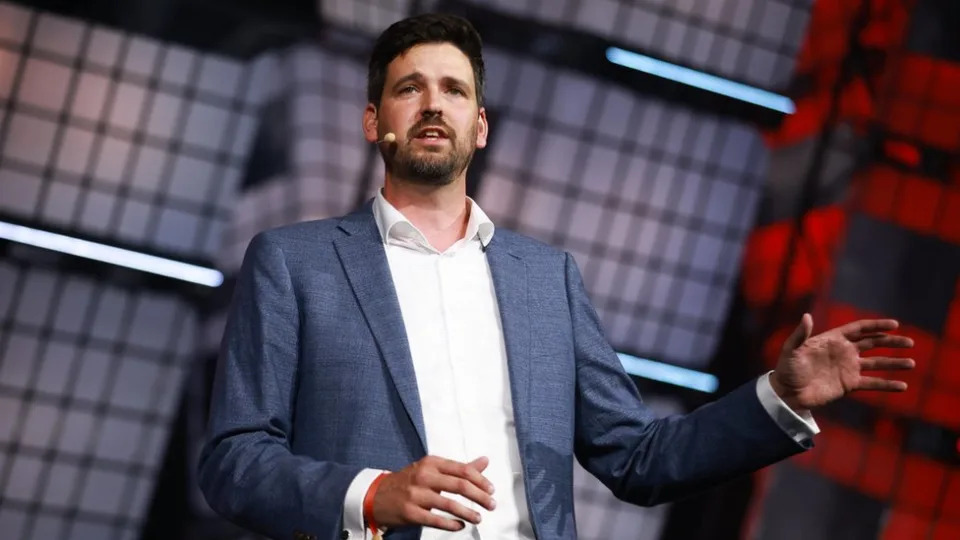George Glover
Wed, July 19, 2023

Robert F. Kennedy Jr., nephew of former U.S. President John F. Kennedy, speaks to people from a wide spectrum, including coronavirus skeptics, gathered under the Victory Column in the city center to hear speeches during a protest against coronavirus-related restrictions and government policy on August 29, 2020 in Berlin, Germany.
Sean Gallup/Getty Images
Silicon Valley and Wall Street stars are indulging Robert F. Kennedy Jr.'s presidential campaign.
Twitter founder Jack Dorsey, SPAC king Chamath Palihapitiya, and hedge fund legend Bill Ackman have all shown support.
RFK Jr. has said that vaccines cause autism – and the White House recently blasted him for sharing anti-Semitic conspiracy theories.
Some of the biggest names in Silicon Valley and on Wall Street just can't get enough of Robert F. Kennedy, Jr., who was rebuked by the White House last week for sharing a "vile" anti-Semitic COVID conspiracy theory.
Backers of the presidential candidate – a member of the Kennedy dynasty who believes that the CIA killed his uncle and vaccines cause autism in children – include Twitter's co-founder and a legendary hedge-fund manager who made billions betting stocks would tank during the pandemic.
Here's a list of high-profile people voicing support for RFK, Jr, who's currently polling in the mid-teens for the Democratic nomination, per FiveThirtyEight:
Billionaire investor and Pershing Square Capital Management CEO Bill Ackman – who's also endorsed JPMorgan CEO Jamie Dimon running for higher office – has repeatedly backed Kennedy on Twitter and donated $3,300 to his campaign in the second quarter, according to a Federal Election Commission filing.
Fisher Investments founder Ken Fisher donated $6,600, per the same filing.
Twitter co-founder Jack Dorsey told the "Breaking Points" podcast last month that he was backing Kennedy, who he said "has no fear in exploring topics that are a little bit controversial and in the future".
Mark Gorton, who created LimeWire and now runs the algorithmic trading firm Tower Research Group, told CNBC in May that he's given over $1 million to Kennedy's anti-vax non-profit, Children's Health Defense.
"SPAC king" Chamath Palihapitiya and PayPal founding exec David Sacks hosted a fundraiser for Kennedy last month. "The Establishment and [main stream media] will paint him with all kinds of labels so you don't give him a chance," Palihapitiya said after.
Some have carried on standing by Kennedy after he suggested during a press event last week that COVID-19 had been genetically engineered to spare Ashkenazi Jewish and Chinese people. (He then denied that those comments were "ethnically targeted").
Ackman briefly condemned the controversial candidate – then claimed he'd "quickly jumped to conclusion based on a headline" and shared a Tweet where Kennedy said he'd been criticizing "ethnically targeted bioweapons", not spreading debunked anti-Semitic conspiracy theories.
This isn't the first time parts of Wall Street and Silicon Valley have backed an anti-establishment firebrand.
In both 2016 and 2020, big names like venture capitalist Peter Thiel and Blackstone CEO Stephen Schwarzman backed Republican candidate Donald Trump. Look how that turned out.
Silicon Valley and Wall Street stars are indulging Robert F. Kennedy Jr.'s presidential campaign.
Twitter founder Jack Dorsey, SPAC king Chamath Palihapitiya, and hedge fund legend Bill Ackman have all shown support.
RFK Jr. has said that vaccines cause autism – and the White House recently blasted him for sharing anti-Semitic conspiracy theories.
Some of the biggest names in Silicon Valley and on Wall Street just can't get enough of Robert F. Kennedy, Jr., who was rebuked by the White House last week for sharing a "vile" anti-Semitic COVID conspiracy theory.
Backers of the presidential candidate – a member of the Kennedy dynasty who believes that the CIA killed his uncle and vaccines cause autism in children – include Twitter's co-founder and a legendary hedge-fund manager who made billions betting stocks would tank during the pandemic.
Here's a list of high-profile people voicing support for RFK, Jr, who's currently polling in the mid-teens for the Democratic nomination, per FiveThirtyEight:
Billionaire investor and Pershing Square Capital Management CEO Bill Ackman – who's also endorsed JPMorgan CEO Jamie Dimon running for higher office – has repeatedly backed Kennedy on Twitter and donated $3,300 to his campaign in the second quarter, according to a Federal Election Commission filing.
Fisher Investments founder Ken Fisher donated $6,600, per the same filing.
Twitter co-founder Jack Dorsey told the "Breaking Points" podcast last month that he was backing Kennedy, who he said "has no fear in exploring topics that are a little bit controversial and in the future".
Mark Gorton, who created LimeWire and now runs the algorithmic trading firm Tower Research Group, told CNBC in May that he's given over $1 million to Kennedy's anti-vax non-profit, Children's Health Defense.
"SPAC king" Chamath Palihapitiya and PayPal founding exec David Sacks hosted a fundraiser for Kennedy last month. "The Establishment and [main stream media] will paint him with all kinds of labels so you don't give him a chance," Palihapitiya said after.
Some have carried on standing by Kennedy after he suggested during a press event last week that COVID-19 had been genetically engineered to spare Ashkenazi Jewish and Chinese people. (He then denied that those comments were "ethnically targeted").
Ackman briefly condemned the controversial candidate – then claimed he'd "quickly jumped to conclusion based on a headline" and shared a Tweet where Kennedy said he'd been criticizing "ethnically targeted bioweapons", not spreading debunked anti-Semitic conspiracy theories.
This isn't the first time parts of Wall Street and Silicon Valley have backed an anti-establishment firebrand.
In both 2016 and 2020, big names like venture capitalist Peter Thiel and Blackstone CEO Stephen Schwarzman backed Republican candidate Donald Trump. Look how that turned out.
















